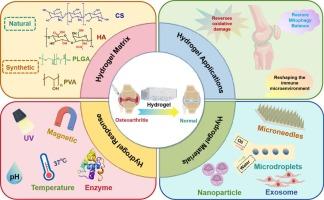智能水凝胶在调节骨关节炎氧化应激和改善免疫微环境中的应用与进展
IF 13.2
1区 工程技术
Q1 ENGINEERING, CHEMICAL
引用次数: 0
摘要
骨关节炎(OA)是一种顽固的、退行性的、复杂的慢性退行性关节疾病。炎症和关节疼痛为主要症状,特征为软骨退变和丢失,以及关节缘和软骨下骨增生,多见于膝关节,多见于中老年人。软骨细胞凋亡和细胞外基质降解是软骨退变的主要原因。目前临床上常用的骨关节治疗药物存在生物利用度低、半衰期短、靶向性差、全身毒性大等局限性。作为一种新兴的智能药物输送系统,水凝胶能够输送生长因子、抗炎药物、类固醇和细胞。它具有关节软骨仿生性能和缓慢可控的负荷释放。能加速软骨修复,刺激软骨再生,调节炎症微环境,延缓骨关节炎的进展。这篇综述的目的是描述不同的水凝胶的分类,水凝胶用于改善骨关节炎的各种症状,它们目前的缺点和未来的前景。本文章由计算机程序翻译,如有差异,请以英文原文为准。

Application and progress of smart hydrogels in regulating oxidative stress and improving the immune microenvironment in osteoarthritis
Osteoarthritis (OA) is a stubborn, degenerating, complex chronic degenerative joint disease. Inflammation and joint pain are the main symptoms, characterized by cartilage degeneration and loss, as well as articular margins and subchondral bone hyperplasia, which are more common in the knee joint and are most common in middle-aged and older people. Chondrocyte apoptosis and degradation of the extracellular matrix are the main causes of cartilage degeneration. At present, there are certain limitations of drugs commonly used in clinical treatment for bone and joint, such as low bioavailability, short half-life, poor targeting, and high systemic toxicity. As an emerging smart drug delivery system, hydrogels are capable of delivering growth factors, anti-inflammatory drugs, steroids, and cells. It has the performance of articular cartilage bionic and slow and controlled release of loads. It can accelerate cartilage repair, stimulate cartilage regeneration, regulate the inflammatory microenvironment, and delay the progression of osteoarthritis. The aim of this review was to describe the classification of different hydrogels, the use of hydrogels for improving the various symptoms of osteoarthritis, their current shortcomings and future prospects.
求助全文
通过发布文献求助,成功后即可免费获取论文全文。
去求助
来源期刊

Chemical Engineering Journal
工程技术-工程:化工
CiteScore
21.70
自引率
9.30%
发文量
6781
审稿时长
2.4 months
期刊介绍:
The Chemical Engineering Journal is an international research journal that invites contributions of original and novel fundamental research. It aims to provide an international platform for presenting original fundamental research, interpretative reviews, and discussions on new developments in chemical engineering. The journal welcomes papers that describe novel theory and its practical application, as well as those that demonstrate the transfer of techniques from other disciplines. It also welcomes reports on carefully conducted experimental work that is soundly interpreted. The main focus of the journal is on original and rigorous research results that have broad significance. The Catalysis section within the Chemical Engineering Journal focuses specifically on Experimental and Theoretical studies in the fields of heterogeneous catalysis, molecular catalysis, and biocatalysis. These studies have industrial impact on various sectors such as chemicals, energy, materials, foods, healthcare, and environmental protection.
 求助内容:
求助内容: 应助结果提醒方式:
应助结果提醒方式:


